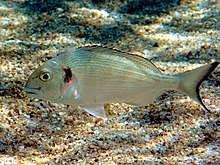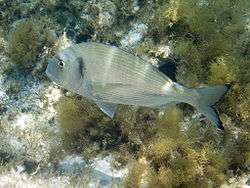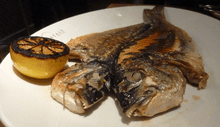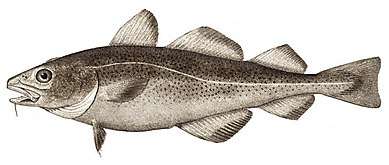Gilt-head bream
The gilt-head (sea) bream (Sparus aurata), called Orata in antiquity and still today in Italy (while in Spain is "Dorada"), is a fish of the bream family Sparidae found in the Mediterranean Sea and the eastern coastal regions of the North Atlantic Ocean. It commonly reaches about 35 centimetres (1.15 ft) in length, but may reach 70 cm (2.3 ft) and weigh up to about 7.36 kilograms (16.2 lb).[2]
| Gilt-head bream | |
|---|---|
 | |
| Sparus aurata | |
 | |
| Scientific classification | |
| Kingdom: | |
| Phylum: | |
| Class: | |
| Order: | |
| Family: | |
| Genus: | Sparus |
| Species: | S. aurata |
| Binomial name | |
| Sparus aurata | |
 | |
| Sparus aurata - Distribution map | |
The gilt-head bream is generally considered the best-tasting of the breams. It is the single species of the genus Sparus – the Latin name for this fish[3] – which has given the whole family of Sparidae its name. Its specific name, aurata, derives from the gold bar marking between its eyes.
The genome of the species was released in 2018, where the authors detected fast evolution of ovary-biased genes likely resulting from the peculiar reproduction mode of the species.[4]
Biology

It is typically found at depths of 0–30 metres (0–98 ft), but may occur up to 150 m (490 ft),[2] seen singly or in small groups near seagrass or over sandy bottoms, but sometimes in estuaries during the spring.[2]
It mainly feeds on shellfish, but also some plant material.[2]
Fisheries and aquaculture
Gilthead seabream is an esteemed food fish, but catches of wild fish have been relatively modest, between 6,100 and 9,600 tonnes in 2000–2009, primarily from the Mediterranean.[5] In addition, gilthead seabream have traditionally been cultured extensively in coastal lagoons and saltwater ponds. However, intensive rearing systems were developed during the 1980s, and gilthead seabream has become an important aquaculture species, primarily in the Mediterranean area. Reported production was negligible until the late 1980s, but reached 140,000 tonnes in 2010, thus dwarfing the capture fisheries production.[6] Greece is the biggest seabream producer in Europe, followed by Turkey.[7]
Gilthead seabream in aquaculture are susceptible to parasitic infections, including from Enterospora nucleophila.
Cuisine

The fish is widely used in Mediterranean cooking, under a variety of names. In Tunisia, it is known locally as "Dorate".
References
- NatureServe (2013). "Sparus aurata". IUCN Red List of Threatened Species. 2013. Retrieved 15 December 2014.CS1 maint: ref=harv (link)
- Froese, Rainer and Pauly, Daniel, eds. (2010). "Sparus aurata" in FishBase. October 2010 version.
- sparus. Charlton T. Lewis; Charles Short. A Latin Dictionary. Perseus Project.
- Pauletto, Marianna; Manousaki, Tereza; Ferraresso, Serena; Babbucci, Massimiliano; Tsakogiannis, Alexandros; Louro, Bruno; Vitulo, Nicola; Quoc, Viet Ha; Carraro, Roberta (2018-08-17). "Genomic analysis of Sparus aurata reveals the evolutionary dynamics of sex-biased genes in a sequential hermaphrodite fish". Communications Biology. 1 (1): 119. doi:10.1038/s42003-018-0122-7. ISSN 2399-3642. PMC 6123679. PMID 30271999.
- FAO (Food and Agriculture Organization of the United Nations) (2011). Yearbook of fishery and aquaculture statistics 2009. Capture production (PDF). Rome: FAO. p. 163.
- "Sparus aurata (Linnaeus, 1758)". Cultured Aquatic Species Information Programme. FAO Fisheries and Aquaculture Department. Retrieved 22 September 2012.
- http://www.fao.org/fishery/countrysector/naso_greece/en
- Alan Davidson, Mediterranean Seafood, Penguin, 1972. ISBN 0-14-046174-4, pp. 86–108.
External links

- a review of most updated knowledge about gilthead seabream from the AQUATRACE EU Project
- Photos of Gilt-head bream on Sealife Collection


.png)
